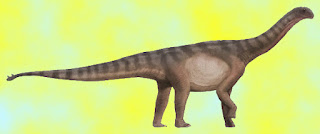Dinosaurs and Dragon Art
When believers in universal common descent evolution are faced with facts contrary to deep time, they get mighty agitated, trying to find rescuing devices to keep the faith. When fossils containing soft tissues in dinosaurs and other critters were found, their excuses failed.
We have examined several instances of art from dates that are reasonably precise. They were referred to as dragons back then. Misotheists wave them off with remarks like, "Can't happen. Because evolution. You're stupid, haw, haw, haw!" Some "scientific" explanations are...truly bizarre.
Darwin requires millions of years to perform his magick, and secular scientist gladly manufacture ways to provide them. Dinosaurs allegedly became extinct about sixty-five million years ago, but dismissals of historical accounts and artwork are not acceptable to inquiring people.
 |
| Shunosaurus, Wikimedia Commons / Smokeybjb (background colors added) (CC BY-SA 3.0) |
What those people (as well as more intelligent evolutionists) fail to consider is that there are startling similarities to creatures only known from fossils that were discovered many years later. The most reasonable explanation is that the earth was created recently, and people saw them before the critters took a dirt nap. More recent verification using digital renders from fossils is even more compelling.
What do we mean by “dragon art”? Our distant ancestors from around the world wrote descriptions; carved statues, figurines, and bas-reliefs; and drew and painted all kinds of terrifying reptiles. Just like modern dragon depictions, most of the historical material resembles no known creature and thus belongs to fiction. But rare instances do match known fossils.
Creation speaker and author Vance Nelson has vetted many dragon artifacts. One of the steps he uses to verify ancient art is to compare it with digital renders (an artist’s computer-generated images) based solely on fossil anatomy. Vance employs an evolutionary paleoartist who unwittingly ends up painting images that match the ancient art. I relied on Vance’s book Dire Dragons when helping design our Dragon Encounters wall. His book shows ancient images of dinosaur look-alikes, plus extinct reptiles that weren’t dinosaurs but whose remains were found in Triassic and even Permian settings.
You can read the entire article at "Dragon Art Defies Millions of Years."